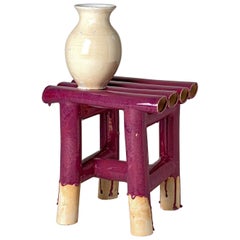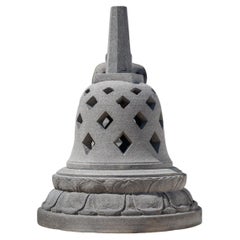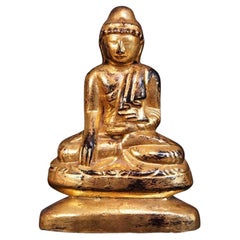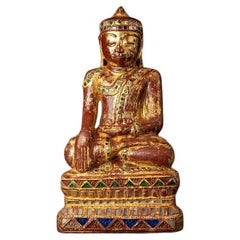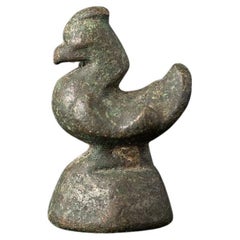Continental Europe - Sculptures and Carvings
to
50
1,304
2,060
1,464
1,194
84
26
35
16
16
11
2
1
1
1
370
481
343
110
110
134
58
14
2
3
2
5
7
8
20
4
4
541
443
375
197
78
1,159
785
672
184
167
1,304
1,253
1,274
14
14
11
6
6
Item Ships From: Continental Europe
Vase on Table in Magenta and Beige Ceramic by Milan Pekar
By Milan Pekar, Rossana Orlandi
Located in Milan, IT
The magazine table belong to the furniture collection “Vase on table”. Taking everyday practical objects found at home and transforming them into ceramics in a playful way without thinking too much of their primary function. Furniture pieces are made of height firing terracotta clay. Actual ceramic tubes...
Category
21st Century and Contemporary Modern Continental Europe - Sculptures and Carvings
Materials
Clay
18th century special antique wooden Burmese Lotus Buddha - OriginalBuddhas
Located in DEVENTER, NL
The special antique wooden Burmese Lotus Buddha is a truly extraordinary and sacred artifact originating from Burma. Crafted from wood and adorned with 24-karat gold gilding, this Buddha statue stands at 51 cm in height and measures 31.3 cm in width and 22.9 cm in depth. The gilded surface adds a radiant and opulent touch to the sculpture, enhancing its visual appeal and spiritual significance.
Dating back to the 18th century, this Lotus Buddha is depicted in the Bhumisparsha mudra, symbolizing the moment of enlightenment. The presence of a hollow space at the back of the base for storing relics adds to its special nature, making it a significant object of devotion and veneration.
With a weight of 7.96 kgs, this special wooden Lotus Buddha is a treasured and valued piece. Originating from Burma, it carries the essence of Burmese craftsmanship and religious traditions. The beautiful expression on the Buddha's face adds to its charm and sacred aura.
This antique Lotus...
Category
18th Century Burmese Antique Continental Europe - Sculptures and Carvings
Materials
Wood
Late 20th century lavastone Stupa from Indonesia OriginalBuddhas
Located in DEVENTER, NL
The lavastone Stupa from Indonesia is a remarkable piece that embodies the spiritual and cultural traditions of the region. Crafted from lavastone, this Stupa stands tall at 93 cm in...
Category
Late 20th Century Indonesian Continental Europe - Sculptures and Carvings
Materials
Lava
Antique Limestone Buddha from Burma
Located in DEVENTER, NL
Material: Limestone
Material: wood
26 cm high
18 cm wide
Weight: 1.618 kgs
Goldplated with 24 krt. gold
Shan (Tai Yai) style
Bhumisparsha mudra
Originating from Burma
19th ...
Category
19th Century Burmese Antique Continental Europe - Sculptures and Carvings
Materials
Wood
Antique Wooden Burmese Buddha Statue from Burma
Located in DEVENTER, NL
Material: wood
35,7 cm high
20 cm wide and 12,5 cm deep
Weight: 2.394 kgs
Gilded with 24 krt. gold
Shan (Tai Yai) style
Bhumisparsha mudra
Originating from Burma
19th centur...
Category
19th Century Burmese Antique Continental Europe - Sculptures and Carvings
Materials
Wood
Antique Bronze Opiumgweight from Burma
Located in DEVENTER, NL
Material: bronze
5,3 cm high
3,1 cm wide and 4 cm deep
Weight: 0.148 kgs
Originating from Burma
18th century.
Category
18th Century Burmese Antique Continental Europe - Sculptures and Carvings
Materials
Bronze
Antique Wooden Shan Buddha Statue from Burma
Located in DEVENTER, NL
Material: wood
42 cm high
22,3 cm wide and 16,5 cm deep
Weight: 3.554 kgs
Gilded with 24 krt. gold
Shan (Tai Yai) style
Bhumisparsha mudra
Originating from Burma
18th centur...
Category
18th Century Burmese Antique Continental Europe - Sculptures and Carvings
Materials
Wood
Antique Wooden Shan Buddha Statue from Burma
Located in DEVENTER, NL
Material: wood
51,5 cm high
31,3 cm wide and 12 cm deep
Weight: 1.721 kgs
Gilded with 24 krt. gold
Shan (Tai Yai) style
Bhumisparsha mudra
Originating from Burma
19th centur...
Category
19th Century Burmese Antique Continental Europe - Sculptures and Carvings
Materials
Wood
Antique Bronze Opiumgweight from Burma
Located in DEVENTER, NL
Material: bronze
4,8 cm high
3 cm wide and 3,5 cm deep
Weight: 0.139 kgs
Originating from Burma
18th century.
Category
18th Century Burmese Antique Continental Europe - Sculptures and Carvings
Materials
Bronze
Antique Wooden Burmese Temple from Burma
Located in DEVENTER, NL
Material: wood
75,5 cm high
67 cm wide and 43,5 cm deep
Weight: 17.8 kgs
Gilded with 24 krt. gold
Mandalay style
Originating from Burma
Late 19th century
Can be shipped worl...
Category
Late 19th Century Burmese Antique Continental Europe - Sculptures and Carvings
Materials
Wood
Antique Wooden Mandalay Buddha Statue from Burma
Located in DEVENTER, NL
Material: wood
38 cm high
24 cm wide and 17,5 cm deep
Weight: 2.941 kgs
Gilded with 24 krt. gold
Mandalay style
Bhumisparsha mudra
Originating from Burma
19th century.
Category
19th Century Burmese Antique Continental Europe - Sculptures and Carvings
Materials
Wood
Antique Bronze Opiumweight from Burma
Located in DEVENTER, NL
Material: bronze
4,8 cm high
3,4 cm wide and 4 cm deep
Weight: 0.159 kgs
Originating from Burma
18th century.
Category
18th Century Burmese Antique Continental Europe - Sculptures and Carvings
Materials
Bronze
Antique Wooden Burmese Shan Buddha from Burma
Located in DEVENTER, NL
Material: wood
57,5 cm high
25 cm wide and 16 cm deep
Weight: 5.65 kgs
With traces of 24 krt. gilding
Shan (Tai Yai) style
Bhumisparsha mudra
Originating from Burma
18th Cen...
Category
18th Century Burmese Antique Continental Europe - Sculptures and Carvings
Materials
Wood
Antique Burmese Marble Shan Buddha Statue from Burma
Located in DEVENTER, NL
Material: marble
Measures: 47,7 cm high
24,5 cm wide and 8,5 cm deep
Weight: 7.342 kgs
Shan (Tai Yai) style
Originating from Burma
18th century
Special !
Category
18th Century Burmese Antique Continental Europe - Sculptures and Carvings
Materials
Marble
Antique bronze Opium Weight from Burma
Located in DEVENTER, NL
Material: bronze
4,5 cm high
3,5 cm wide and 4 cm deep
Weight: 0.154 kgs
Originating from Burma
18th century
Category
18th Century Burmese Antique Continental Europe - Sculptures and Carvings
Materials
Bronze
Antique bronze Opium weight from Burma
Located in DEVENTER, NL
Material: bronze
5,3 cm high
3,4 cm wide and 3,5 cm deep
Weight: 0.134 kgs
Originating from Burma
18th century
Category
18th Century Burmese Antique Continental Europe - Sculptures and Carvings
Materials
Bronze
Antique Bronze Opium Weight from Burma
Located in DEVENTER, NL
Material: bronze
6 cm high
4,9 cm wide and 4,9 cm deep
Weight: 0.308 kgs
Originating from Burma
19th century.
Category
19th Century Burmese Antique Continental Europe - Sculptures and Carvings
Materials
Bronze
Antique Bronze Opiumweight from Burma
Located in DEVENTER, NL
Material: bronze
4,9 cm high
4,3 cm wide and 4,5 cm deep
Weight: 0.286 kgs
Originating from Burma
18th century
Category
18th Century Burmese Antique Continental Europe - Sculptures and Carvings
Materials
Bronze
Antique Nyaung-Yan Buddha from Burma
Located in DEVENTER, NL
Material: bronze
19 cm high
13 cm wide
Weight: 1.6 kgs
Ava style
Bhumisparsha mudra
Originating from Burma
16/17th century - Nyaung-Yan (Ava) period
Traces of 24 krt. gold c...
Category
Early 17th Century Burmese Antique Continental Europe - Sculptures and Carvings
Materials
Bronze
Antique Wooden Burmese Buddha Statue from Burma
Located in DEVENTER, NL
Material: wood
37,5 cm high
18,3 cm wide and 13,3 cm deep
Weight: 2.797 kgs
Gilded with 24 krt. gold
Shan (Tai Yai) style
Bhumisparsha mudra
Originating from Burma
18th cent...
Category
18th Century Burmese Antique Continental Europe - Sculptures and Carvings
Materials
Wood
Antique Wooden Burmese Monk Statue from Burma
Located in DEVENTER, NL
Material: wood
78 cm high
30,3 cm wide and 23 cm deep
Weight: 7.35 kgs
With traces of 24 krt. gilding
Mandalay style
Originating from Burma
19th century
With inlayed eyes.
Category
19th Century Burmese Antique Continental Europe - Sculptures and Carvings
Materials
Wood
Antique Shan Buddha on Throne from Burma
Located in DEVENTER, NL
Material: lacquerware
85,5 cm high
38 cm wide and 29,5 cm deep
Weight: 4.1 kgs
Gilded with 24 krt. gold
Shan (Tai Yai) style
Bhumisparsha mudra
Originating from Burma
19th c...
Category
19th Century Burmese Antique Continental Europe - Sculptures and Carvings
Materials
Lacquer
Antique Wooden Burmese Shan Buddha from Burma
Located in DEVENTER, NL
Material: wood
63,8 cm high
29,5 cm wide and 15,5 cm deep
Weight: 4.345 kgs
With traces of 24 krt. gilding
Shan (Tai Yai) style
Bhumisparsha mudra
Originating from Burma
18t...
Category
18th Century Burmese Antique Continental Europe - Sculptures and Carvings
Materials
Wood
Antique Bronze Opium Weight from Burma
Located in DEVENTER, NL
Material: bronze
6,9 cm high
3,8 cm wide and 4,7 cm deep
Weight: 0.321 kgs
Originating from Burma
19th Century
Category
19th Century Burmese Antique Continental Europe - Sculptures and Carvings
Materials
Bronze
Antique Bronze Opium Weight from Burma
Located in DEVENTER, NL
Material: bronze
4,1 cm high
2,7 cm wide and 3,3 cm deep
Weight: 0.076 kgs
Originating from Burma
19th Century.
Category
19th Century Burmese Antique Continental Europe - Sculptures and Carvings
Materials
Bronze
Antique wooden Burmese Shan Buddha from Burma
Located in DEVENTER, NL
Material: wood
41,8 cm high
20,5 cm wide and 12,3 cm deep
Weight: 2.215 kgs
With traces of 24 krt. gilding
Shan (Tai Yai) style
Bhumisparsha mudra
Originating from Burma
19t...
Category
19th Century Burmese Antique Continental Europe - Sculptures and Carvings
Materials
Wood
Antique wooden Burmese temple from Burma Original Buddhas
Located in DEVENTER, NL
Material: wood
53,2 cm high
34,2 cm wide and 28,3 cm deep
Weight: 5.383 kgs
Gilded with 24 krt. gold
Mandalay style
Originating from Burma
19th century
Category
19th Century Burmese Antique Continental Europe - Sculptures and Carvings
Materials
Wood
Claude Viseux, Abstract Sculpture, 1970s, Stainless Steel
By Claude Viseux
Located in SAINT-SEVER, FR
Claude Viseux est un peintre, sculpteur et graveur aquafortiste et lithographe français né le 3 juillet 1927 à Champagne-sur-Oise et mort le 9 novembre 2008 à Anglet.
'est dans les années 1959-1960 que la sculpture de Claude Viseux, qualifiée de « protéiforme, onirique, fantastique » — ami de Max Ernst, Man Ray, Francis Ponge et Henri Michaux, il ne désavoue pas une parenté avec le Surréalisme9 — se substitue à la peinture, ses premières réalisations étant les objets trouvés en bord de mer qu'il pétrifie dans la cire10 d'une part, les empreintes de pierres et d'algues coulées en bronze d'autre part.
En 1960, il signe le Manifeste des 121 titré « Déclaration sur le droit à l’insoumission dans la guerre d’Algérie ».
En 1961, ses expérimentations s'orientent vers les corps organiques, notamment avec sa série Ostéales constituée d'assemblages d'os fossilisés qu'il patine ou au contraire décape, qu'il visse, scie, assemble et plastifie. Les Concrétudes ou Coulées directes qui suivent en 1961-1962 sont obtenues à partir de coulées de métal en fusion dans le sable, générant des reliefs qu'il soude sur des plaques d'acier. Il va cependant adopter rapidement l'acier inoxydable — qu'il est avec Pol Bury parmi les premiers à employer en sculpture — comme matériau de prédilection. « Il assemble divers rebus industriels — tuyaux, écrous, boulons, cuves… — pour créer des sculptures à mi-chemin du mécanique et du biologique » restitue ainsi Sophie Serra11. Claude Viseux, qui fréquente alors Jean Tinguely, Piotr Kowalski, Michel Guino, Takis et César, confirme : « Ma récupération de l'élément industriel s'élargit vers les aciers spéciaux, avec un essai de vocabulaire formel : des barres, des profilés, des sphères, des rotules, des fonds de cuves, des chambres à combustion de Boeing, des tubulures, des soupapes de navire »9.
« L'artiste entre au cœur de la réalité industrielle, prospecte dans les chaînes de montage de Renault et rôde dans les terrains vaques autour des usines », restitue donc l'encyclopédie Les Muses : « il récupère ferrailles, pièces détachées, débris de voitures, vieux châssis, toute une série d'éléments devenus inutiles. Ils les assemblent, tels quels, sans les modifier. Des créatures agressives ou pathétiques vont surgir de ce combat physique et dialectique que l'artiste livre avec la matière et entrer dans le domaine d'une poétique étrange, surnaturelle5 ». Dans les années 1967-1970, Les « structures actives » en acier inoxydable procèdent ainsi de la production industrielle de série. Elles se répartissent en familles de formes combinatoires composées par addition, soustraction, multiplication, division. Il confirme : « le monde industriel est ma nature, mon bouillon de culture, où je cherche des corps, des familles de corps, des genres, des espèces, dans un aller-retour de l'artificiel au naturel pour confondre les règnes, pour en inventer d'autres selon une géométrie organique qui féconde les différents types de structures, qui aménage la forme concernée par la forme à venir »9. En 1968, Claude Viseux s'installe à la villa Baudran à Arcueil, atelier qu'il conservera jusqu'en 1992.
Si des corps imaginaires naissent ainsi des pièces mécaniques que Claude Viseux emprunte à l'automobile, à l'avion et au bateau, en 1972, « la symétrie de ces formes pures en inox », constate Lydia Harambourg, « l'amène à s'interroger sur la notion d'équilibre instable »12. Ses Instables sont de la sorte exposés à la Biennale de Venise en 1972 où, rappelle encore Lydia Harambourg, une salle entière est consacrée « aux dessins qui reprennent son vocabulaire mécanique identitaire de sphères, toupies, hélices, anneaux, astrolabes et balanciers »12. Les Instables sont de même, en 1973, présentés à la galerie Le Point cardinal à Paris où Claude Viseux avait déjà exposé en 1968 avec Henri Michaux et Joaquin Ferrer...
Category
1970s Unknown Vintage Continental Europe - Sculptures and Carvings
Materials
Stainless Steel
Read More
12 Calming Spaces Inspired by Japanese Design
From cherry-blossom-adorned walls paired with glamorous lighting to wood-paneled ceilings above checkerboard-patterned chairs, these 12 spaces seamlessly blend Eastern and Western aesthetics.
Rodrigo Rivero Lake’s Mexico City Showroom Is a Museum-Worthy Trove of Spanish Colonial and Asian Antiques
The dealer and curator has spent the past 50 years amassing a collection of exceptional art, furniture and architectural elements that trace the cultural influence of the Spanish empire from Europe to the Americas and beyond.
